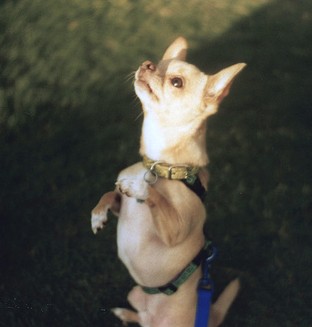
A chihuahua "chipmunks" for a treat, a trick he's been taught and since learned was very successful way to influence humans.
(Photo credit: Wikipedia)
Have you ever seen a well trained dog and thought, “I wish my dog could do tricks like that”?
It is probably the dream of most dog owners to be able to teach their pet to do some of the tricks they see other dogs doing, but there is one thing they must remember above all others before starting down the path of teaching tricks. The dog must have at least some basic obedience. There is not much chance of teaching it to do tricks if it is a badly behaved dog in the first place.
The basic commands such as sit, down, heel etc, should be known by your dog before trick training starts, as this will make life so much easier later on. Once these have been mastered you can begin to build on them and your dog will soon be amazing your friends with the following three simple tricks.
Begging
To start teaching this trick it is best to have your dog sit in a corner of the room with his back to the wall and you standing in front of him. The walls will support your dog and give him the confidence that he won’t fall over if he raises his front legs off the floor.
Take some small pieces of food and hold it above your dog whilst enticing him to reach up for it. Each time he takes the food, praise him and repeat the procedure slowly encouraging him to reach higher each time.
Whilst encouraging the dog to reach up for the food, you must make sure that he is keeping his haunches on the ground. This is achieved by moving the food back over his head slightly making the dog shift his weight back over his haunches and teaching him to keep his balance.
Once the begging trick has bee mastered in the corner of the room you can gradually begin to move away from the wall and practise the trick where the dog has no back support. You must expect at this stage that the dog will seem to go backwards in his learning, but this is to be expected until he can perfect it just using his own body weight.
Shaking hands
There are two parts of this trick for your dog to learn. A verbal part and a non-verbal part which both work together to give the dog a cue that you want him to perform the trick.
Firstly the dog should start off in a sitting position. Give him a single word verbal command such as ‘shake’, whilst at the same time reaching out with your right hand until it is just a few inches from your dogs’ right leg. Your outstretched hand is the non-verbal cue.
Initially your dog will probably just sit motionless unsure of what to do, so with your left hand, gently push or prod his right leg forwards until it rests in your right hand. When he has done this, praise him so that he knows he has done what you wanted him to do.
Practice this trick several times; praising after each successful result and gradually reducing the amount of left hand prompting until only the verbal and non-verbal cues are all that are needed.
Shaking the head: ‘No’
Before you can begin to teach this trick to your dog, you will need to find something which will make him shake his head naturally. Some things which may help are blowing gently on the ear, tickling the ear with a feather or even lightly attaching a paperclip to the ear – remembering that you should not cause the dog any pain.
Once you have found the method which makes him shake his head you will then have to decide on which verbal and non-verbal cue you want to use. A single word such as ‘head’ along with shrugging of your shoulders is just one idea.
Again your dog should start in a sitting position when first teaching him this trick. As in the shaking hands trick, use both cues together, along with the prod (tickling his ear, etc) in an effort to stimulate your dog to shake his head. Once he does, reward him, even if it is just a small movement.
This trick is best learned in short sessions with momentary breaks in between, so don’t try to repeat the exercise more that five times in one session or the dog will become confused and not learn.
Gradually reduce the amount of prodding so that all that are needed are the verbal and non-verbal cues. Once your dog has mastered the trick, he can be progressed to learn it in standing position and laying positions as well.
The main thing with training dogs to perform tricks is for the owner to learn that patience is a virtue and that the dog will learn in his own time. Do not scold the dog if he does not seem to be learning, it is always better to be patient and encourage him more.


No comments:
Post a Comment